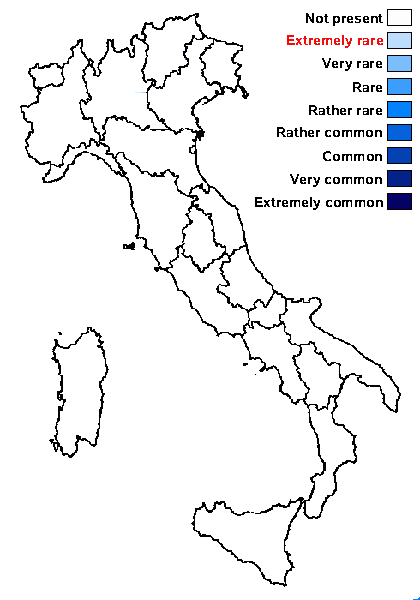Biatorella tiroliensis H. Magn.
in Rabenh. Krypt.-Fl., 2 ed., 9, 5.1: 19, 1935
Synonyms:
Distribution:
Description: Thallus crustose, pale grey, very thin and usually inconspicuous. Apothecia biatorine, 0.4-0.7 mm across, reddish brown, not constricted at base, with a strongly convex disc, immarginate from the beginning. Proper exciple poorly developed, of more or less parallel hyphae, I+ blue; epithecium pale orange-yellow, K-; hymenium colourless to pale yellow, I+ deep blue; paraphyses richly branched and anastomosing in upper part; hypothecium pale yellowish brown to red-brown. Asci 30-50-spored, cylindrical to clavate, with a simple, K/I± faintly blue apical dome cap surrounded by weakly amyloid wall layers, Biatorella-type (see Hafellner & Casares-Porcel 1992). Ascospores 1-celled, hyaline, globose, c. 4.5 µm. Photobiont chlorococcoid. Spot tests: K-, C-, KC-, P-, UV-. Chemistry: without lichen substances.
Note: a terricolous species, probably belonging to the B. germanica-group, but with fewer ascospores per ascus, only known from the type locality in Austria (Tyrol). To be looked for in the Italian Alps.
Growth form: Crustose
Substrata: soil, terricolous mosses, and plant debris
Photobiont: green algae other than Trentepohlia
Reproductive strategy: mainly sexual
Poorly known taxon in need of further study

Predictive model
Growth form: Crustose
Substrata: soil, terricolous mosses, and plant debris
Photobiont: green algae other than Trentepohlia
Reproductive strategy: mainly sexual
Poorly known taxon in need of further study

Predictive model
 Index Fungorum
Index Fungorum
 GBIF
GBIF

